

FC Barcelona broke a three-game winless run in the league at the Estadi Mallorca Son Moix, winning 5-1 in an end-to-end encounter. The win was a welcome return to form as the team couldn’t afford to lose further ground in the title race with both Real Madrid and Athletico Madrid in touching distance of the top of the table.
Barcelona saw Lamine Yamal get back into the starting lineup, a welcome event considering that without him in the lineup this season in the league, Barça haven’t won a game yet. Alejandro Balde also returned to the starting eleven after the injury suffered in the previous round against Las Palmas. Ferran Torres also saw a rare start up front as Robert Lewandowski was rested keeping the upcoming schedule in mind.
Passmaps:
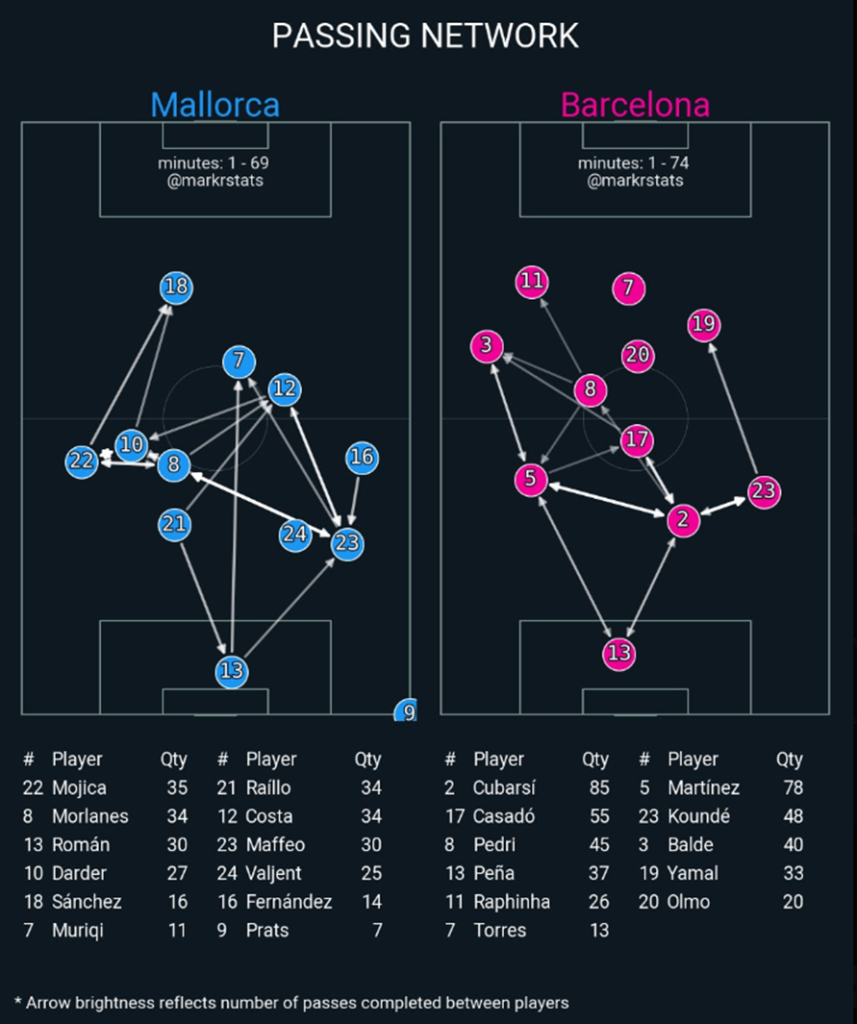
The passmaps indicate that this was a game that was played predominantly in the center of the park, with both teams attempting to press high up the pitch. This was reflected in two metrics: The filed tilt (48.6% to 51.4%)and the average height of the defensive lines (44.3m to 50.6m) of both teams were largely similar. However, despite the similarity in game approach, the score line was evidently one sided. Barça recorded an XG of 5.24 in the game, which is the most recorded by a team in La Liga over the last three seasons. Mallorca on the other hand had an XG of only 0.5, despite them looking dangerous on a few occasions throughout the game.
Barça’s 4-3-3/4-2-3-1 on paper morphed into what was essentially a three-man backline for large parts of the game, as Alejandro Balde was tasked with holding width on the left flank. Raphinha, as always, drifted inside more often than not, so much so that his heatmap for the game would be that of a second striker. Lamine Yamal also had more of a presence in the central areas than usual, as Mallorca’s high press and desire to be very direct in attack left a fair amount of space for the winger to exploit.
Figure 1: Raphinha and Lamine’s heatmaps. Notice how central their positions are, specially Raphinha’s.


Figure 2: Key game stats
Ferran Torres’s inclusion in the starting lineup also had a significant impact on how Barça attacked and defended. Positionally, Ferran is a different type of player to Lewa in terms of their positioning and how they read the play; Lewa prefers to drop into the left half space and get on the ball more, while Ferran tends to stretch the backline with runs in behind. He also has a propensity to drift towards the flanks more than the center (logical as his natural position is that of a winger). Therefore, Ferran’s presence led to Barča having a noticeably different shape in attack and in defence, summarized as follows:
- In attack, Ferran attacking depth constantly meant that Olmo had more time and space on the ball in between the pockets, where he is at his most dangerous. The penalty that led to the second goal showcased this, as Olmo was able to receive and turn in one fluid motion to beat his marker ad play the ball through to Lamine.
- Not having Ferran drop into midfield meant that Lamine had the freedom to drift inwards more. This worked well because Lamine is absolutely not a player that should be confined to the touchline; his talent and gravity demand that he be on the ball as far as possible (An attribute he shares with Pedri)
- In defense, Barça’s defense shape as they press in the opponent’s half is highly conditioned by Lewandowski’s physicality (and lack thereof). In most games this season, Barça press with their wingers first and foremost, as they press diagonally inward from the flanks, while Lewa aims to block central progression by having the opponent’s CDM in his cover shadow. This is evidently done in order to have Lewa not make long sprints and conserve his energy. However, this also means that the out ball for the opposition is almost always the winger or the fullback high up the pitch. Having Ferran up top meant that Barça pressed in a more traditional manner, which lessened the physical burden on the fullbacks.
Lamine’s magic:
This was Lamine’s first start in four games, and it showed. His touches were off, while he definitely didn’t have his shooting boots on, as he scuffed a couple of very presentable opportunities wide. However, Lamine has a trait that only the very best possess: He can still destroy teams on an off day. The magnitude of his talent is such that you can never keep him fully quiet; he will find a way to hurt you at least a couple of times in the game. By his standards, this was a relatively quiet evening. However, he had a few moments of magic, with his two trivela passes to Raphinha and Pau Victor being truly exceptional pieces of skill and vision. The trivela is quickly becoming a Lamine Yamal trademark; we’ve seen this pass on multiple occasions already. This is in addition to his already exceptional crossing ability done in the traditional manner, making him deadly out wide.
Figure 3: Lamine’s trivela assists this season, against Villareal, Espanyol and Mallorca

The reason this outside of the foot pass is so deadly can be explained by two words: angle bias (or the lack of it). Football is essentially a matter of exploiting angles. The fewer angles of play that are inaccessible to a player, the harder he becomes to pay against. In the leadup to Raphinha’s first goal, when Lamine picks up the ball on the wings, there really isn’t any sense of danger for Mallorca; the pass inside to the half space has been blocked off (there are 3 Mallorca players with an eye on Jules Kounde in the half space, and even if Kounde receives the ball there somehow, he’s still a converted CB in a confined space), and Raphinha has the attention of two defenders in the box. 99% of the time, the ball goes backwards in a scenario like this.
The trivela caught the entire Mallorca backline off guard. The keeper couldn’t come out to claim the cross as it was placed beautifully in between the defenders and goalkeeper, as the shape of the pass resulted in the ball naturally curving away from the keeper. I liken this cross to a ball bowled in cricket in, what’s called the corridor of uncertainty. (This is where the ball is bowled just outside the off stump, where the batsman is forced to decided between playing it and letting it go, the dilemma caused here is where the phrase ‘corridor of uncertainty’ comes from). Credit must also be given to Raphinha, who’s movement to keep himself onside and time the run to perfection was key to the goal.
Figure 4: An unbelievable trivela

Lamine executed another inch perfect outside of the boot pass to Pau Victor in the buildup to Frenkie de Jong’s goal as well.
Speaking of Frenkie, he had a very positive cameo appearance. Apart from the goal, he showed great instincts in the leadup to Pau Victor’s goal, as his fresh legs and energy (and reading of the play) allowed him to surprise the Mallorca left back J. Mojica (who thought he had just tackled Lamine and assumed that the danger had been dealt with). Frenkie’s role as he came on was not his usual one. While the game state and scoreline definitely played a significant part in his role and position on the pitch, the performance brought back memories of Frenkie’s role of being a box crasher under Ronald Koeman. This could turn out to be a very interesting alternative, as this role would allow Frenkie to have a lot more positional freedom and take advantage of his incredible athleticism. It remains to be seen if Flick would consider this role more often down the line, but it’s certainly an option that would make Barça quite unpredictable.
Mallorca’s difficulties in this game:
Barça this season are very obviously a different team stylistically under Hansi Flick as compared to previous iterations. While the old Barça would more often than not build patiently, circulating the ball with the idea of moving the opposition block in order to find space between the lines, this version is far more direct in their approach. This new approach obviously has its pros and cons. While it leads to games that turn out to be quite stretched and transitional in nature, resulting in Barça often looking like they’re voluntarily ceding control of the game in favour of greater chance creation, the approach plays to the strengths of the Barça frontline, in particular Raphinha and Ferran, who’s playstyles are more suited toward a direct, transitional game (logical as their greatest attributes are their off the ball movement). Now, against opponents who are equally suited to this manner of playing, this would be a very risky approach. However, Mallorca are not a team with pacy forwards in transition. They are a team that rely a lot on their strength and physicality, with Vedat Muriqui being the lone man up to, tasked with being a monstrous aerial threat in the box. So, while Mallorca had their chances to create more clear-cut opportunities, they didn’t have the profiles to match Barça in an end to end, open contest.
To be fair to Mallorca, they do have this trait in common with a number of other La Liga teams. Flick’s approach seems to have jolted the league in a manner not dissimilar to Michel’s Girona last season. Jagoba Arrasate’s plan to match the chaotic/direct energy of Barcelona played right into the game in the long run, as the rushed speed of play resulted in a number of turnovers for both teams. However, Barça (unlike Mallorca), with the superior quality of players, were able to take advantage of the transitional nature of the game. In a game where both teams are trying to play with a high line, it is inevitable that there will be plenty of moments of ball loss and chances created. Its only a matter of who takes their chances.
This is also a lesson to Barça, to learn how to control different game states. Flick’s team have done very well in the league so far, but its also clear that they need to incorporate more moments of calm, with controlled possession. They certainly do not lack the players to do this, as a midfield roster of Frenkie, Pedri, Gavi, Casado and Olmo have the technical ability and mental profile to play this way. Again, its important to state that this is not a matter of tactics, but more a matter of mentality.
Takeaways:
All things considered, this was a crucial three points for Barça, who couldn’t afford another slip up. While the scoreline and the XG for each team suggests an absolute demolition, the game was closer than what the final score suggested. That isn’t to take anything away from Barça, as playing away at Son Moix is never a easy proposition. Mallorca came into this game sixth in the table, having drawn against Real Madrid at home previously. Moreover, games against a Jagoba Arrasate team are never comfortable; they tend to be tightly contested affairs full of hard running and intensity, with a blowout win being a rarity. Considering that, and the form that Barça had coming into the game, the result turned out to be a pleasant surprise.
Next up for Barça is a game at home against Real Betis, a game which promises to be a banger.

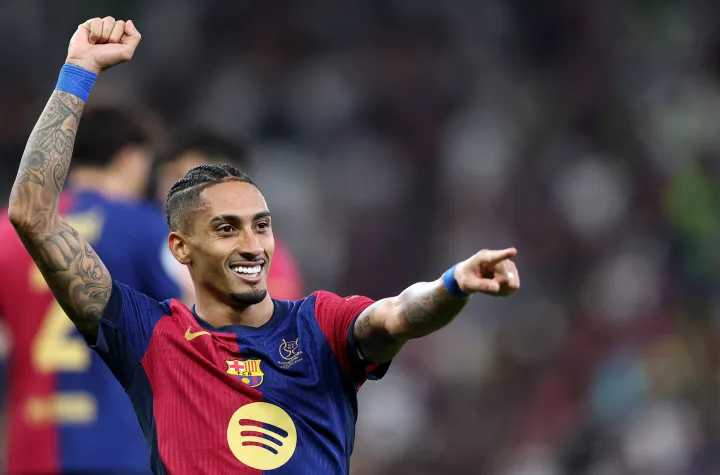
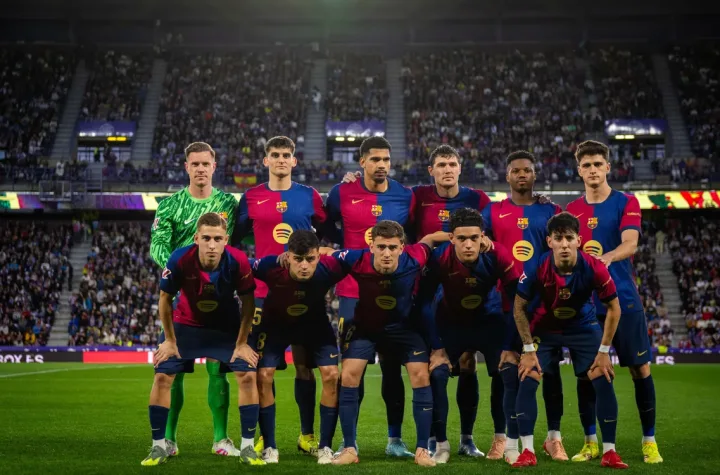
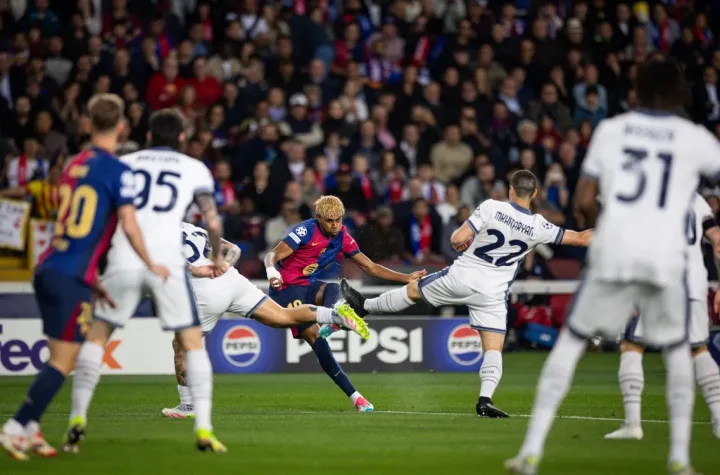
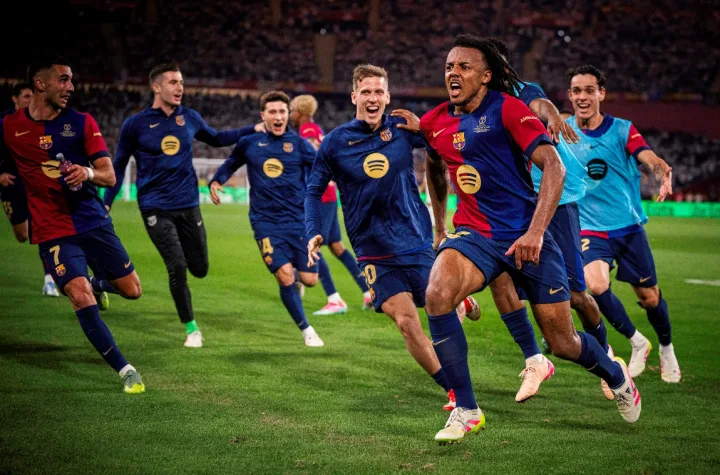
More articles
A rotation squad gets Barcelona closer to the LaLiga title
Lamine Yamal shines in the Champions League semi-final
Barcelona’s victory at the Copa del Rey: an exercise in resilience for the club